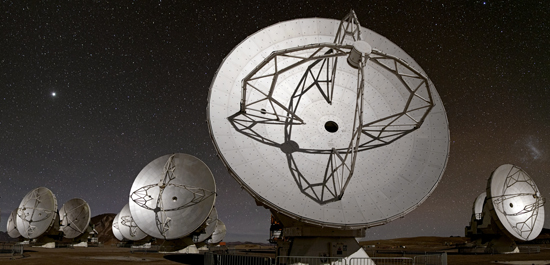Where Stars Come From
Super telescopes peer inside a cloud where stars may be born
James Jackson spends a lot of time staring into space. Much of the time he is looking at clouds of dust and gas. One cloud in particular—a dark, opaque mass that astronomers call “the brick,” near the center of the turbulent Milky Way, is of special interest, because astronomers believe it may be an active incubator of stars.
For years, Jackson, a College of Arts & Sciences professor of astronomy, and his international colleagues studied the brick with the most powerful telescopes available and saw only, well, a brick, impenetrable and opaque. That changed last year with the unveiling of a powerful new tool called the Atacama Large Millimeter/submillimeter Array (ALMA), a collection of 66 dish antennae, or radio telescopes, spread across an almost 10-mile stretch of Chile’s high-altitude Atacama Desert. The $1.4 billion project, to be fully functioning by the end of 2013, is three decades in the making and involves astronomers from Europe, North America, Japan, and Australia.
“ALMA’s going to blow the field wide open,” says Jackson, CAS associate dean for research and outreach, who was among the first astronomers to use the array. “We are poised to understand the origins of stars in an unprecedented way and that’s the origin of us.”
Four years ago, Jackson and former BU postdoctoral research fellow Jill Rathborne, a senior research scientist at the Commonwealth Scientific and Industrial Research Organization in Sydney, Australia, and principal investigator of one of ALMA’s first missions in 2012, became fascinated with the brick, which is far larger and more dense than other clouds, and incorporates smaller blobs that each are about 8 to 150 times the mass of the sun. It had everything that astronomers believe is needed to be a star-making engine.
“If this makes a cluster,” Jackson says, “it’s going to make the mother of all clusters.”

The brick, in fact, was so promising that astronomers agreed to make it one of the focuses of ALMA’s inaugural mission, employing 25 antennas over a six-hour period. That project yielded images unlike anything the astronomers had seen. They showed a space webbed with luminescent filaments and punctuated by a multitude of blobs of various sizes, all set against a backdrop of filmy dust (which comprises only about one percent of the cloud’s mass compared to gas). Comparing the ALMA images to what they had seen with other equipment, Jackson says, is like putting on eyeglasses for the first time. What had been a blur now sparkles with detail.
Clouds like the brick are extremely cold, he says. They register at only 10 degrees above absolute zero. The gas and dust within them emit relatively long wavelengths, straddling the radio and infrared ranges of the electromagnetic spectrum, which are captured by telescopes like ALMA. Astronomers believe that their gas clouds heat up when they collapse under their own weight. With sufficient heat, says Jackson, they could churn out stars and clusters of stars.

That’s what ALMA has the power to reveal. “We’re hoping to find and characterize the brick’s small stellar embryos,” says Rathborne. “By counting how many there are, measuring their masses, and determining how they are moving with respect to one another, we can begin to test theories that describe how the most massive clusters of stars are formed.”
The brick is so massive, Jackson says, that it could produce thousands or tens of thousands of stars. If, that is, it actually produces stars.
“The jury is out,” he says. “We don’t know for sure if there are any stars forming in there.”
One thing that could hinder the brick’s star making, says Jackson, is its location. It sits near the center of our Milky Way galaxy, which means that it’s probably exposed to intense radiation and magnetic fields that constantly stir the cloud’s contents and could thwart the collapse of material needed to generate heat.
In fact, ALMA has revealed what look like cold filaments streaking through the center of an otherwise hot cloud. “It’s like baked Alaska,” Jackson says. “You have hot on the outside and ice cream in the middle.” One reason might be that the entire cloud is collapsing to form a big cluster, “but that’s highly speculative.”
The latest cycle of ALMA observations began in January and will continue throughout this year, says Rathborne, who doesn’t expect to see results for several months. Combined with the revelations of ALMA’s first observations, she says, “the images will reveal a wealth of information about how the most massive star clusters in our galaxy are formed.”
Comments & Discussion
Boston University moderates comments to facilitate an informed, substantive, civil conversation. Abusive, profane, self-promotional, misleading, incoherent or off-topic comments will be rejected. Moderators are staffed during regular business hours (EST) and can only accept comments written in English. Statistics or facts must include a citation or a link to the citation.